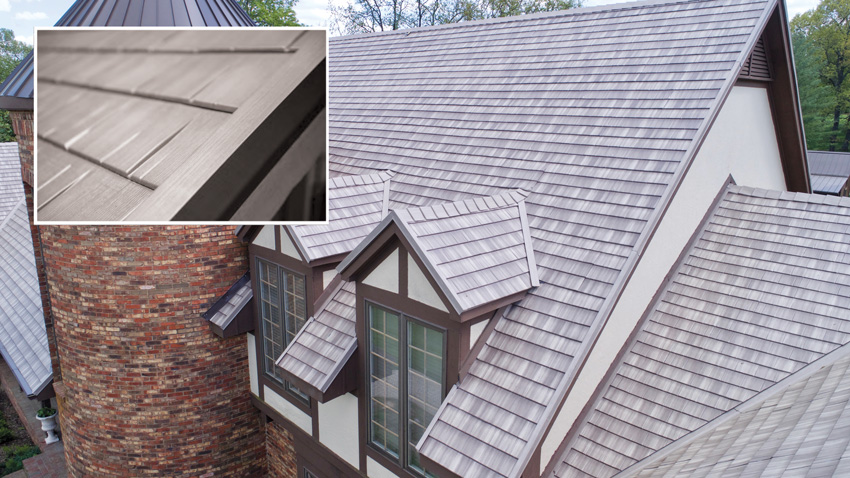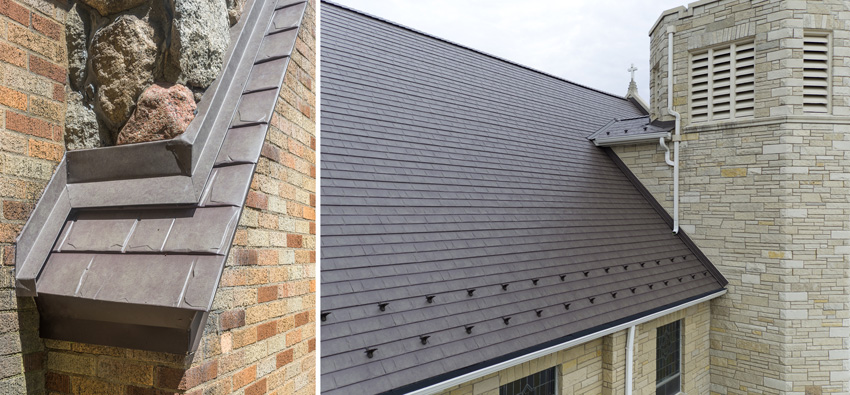Metal Roofing with the Appearance of Traditional Materials
Learning Objectives:
- Identify and recognize the high-performance characteristics of metal roofing (wind and weather resistance, fire classification, and durability) as determined by national standards.
- Investigate the design potential and innovative opportunities to use metal roofing in a variety of profiles and colors to create sustainable buildings.
- Assess the functional contributions of metal roofing as part of the green and sustainable design of a building.
- Specify metal roofing in a variety of green and conventional buildings by selecting from many choices and options.
Credits:
This course is approved as a Structured Course
This course can be self-reported to the AANB, as per their CE Guidelines
Approved for structured learning
Approved for Core Learning
This course can be self-reported to the NLAA
Course may qualify for Learning Hours with NWTAA
Course eligible for OAA Learning Hours
This course is approved as a core course
This course can be self-reported for Learning Units to the Architectural Institute of British Columbia
Metal roofing has been around a long time. That can be said in general terms as well as on specific buildings, which explains its well-earned reputation for long-term durability and enduring appearance. These longevity characteristics bode well in light of current demands for greater sustainability and better material choices in buildings. Metal roofing also supports a strong return on investment over the longer term since, in many cases, it can contribute to lower cost of ownership in terms of reduced maintenance, potential energy savings, and insurance premium savings. Given these popular advantages, it is easy to see why metal roofing has become a huge segment of the U.S. roofing industry at more than $4 billion annually. It is also the fastest-growing segment in the roofing industry with a forecast to be more than $7 billion by 2024, according to the industry market research firm The Freedonia Group.

All images provided by CertainTeed
Architects looking to achieve the look of clay tile, wood shake, or slate shingle roofing but want the durability and lighter weight of metal roofing can now design and specify metal roofing to meet these needs.
When thinking of metal roofing, however, many architects, owners, and others envision standing-seam or corrugated profiles as their only choices. In fact, those who look a little closer are also discovering that it is available in more looks, colors, and types than they may have thought. In particular, it is available in patterns that very effectively mimic other traditional residential roofing materials, such as clay tile, slate shingles, or wood shakes. This course will look at some of the current choices, options, characteristics, and green building properties of metal roofing available, particularly those with traditional appearances.
Building Designs With Metal Roofing
Standard metal roofing products come in some common types and styles that do include standing-seam profiles and corrugated profiles along with stone-coated metal panels. All of these are fairly versatile products and bring all of the desirable properties of metal roofing to a building, while also providing a strong, visible aesthetic for a variety of architectural styles. However, they also have some limitations that need to be taken into account when it comes to their use on traditional-style residential and light commercial projects.
Standing-seam metal roofing provides a defined pattern of clean lines with all fasteners and connectors concealed from view when the installation is complete. It can provide the roofing for a complete building or be judiciously selected for an accent section in contrast to other roofing materials on a building. Either way, the final appearance is limited to a selection of standard solid colors as available from manufacturers—patterns or textures are not readily obtainable. In some cases, the sleek appearance can clash with a traditional or historical design, particularly for a residential building since the standing seams can be seen as more of a commercial or institutional look. From a construction viewpoint, standing-seam metal roofing can be more challenging to install than other roofing materials. The individual panels are intentionally long and can be cumbersome to handle, all requiring specialty trades and tools for a successful installation. Of course, those needs contribute to higher installation costs compared to some other metal roofing options.
Corrugated steel roofing refers to any type of corrugation whether a low-profile and asymmetrical pattern or a full-depth, continuous corrugation across a roofing panel (i.e., with a similar look of cardboard corrugations.) The corrugations add strength to the metal panels and help facilitate the overlapping of adjacent pieces to maintain weathertightness. They are typically less expensive to install, which means they have been associated with agricultural and industrial buildings more than with residential and light commercial ones. The available colors are limited to the solid color choices provided by manufacturers, including “bare metal” galvanized choices. The final appearance usually includes exposed fasteners, which may or may not detract from the overall design but can certainly increase the potential for water leaks.
Stone-coated metal is available for installations where different colors or textures are sought compared to solid colored metal. However, the stone coating works best on smaller-sized panels, ultimately meaning more labor is needed to install more individual panels using more fasteners than painted metal panel options. In some cases, a batten system may be selected as part of the design, which increases the cost notably. The stone coating also inhibits the ability of the metal to be resistant to algae growth due to the metallurgical reaction between the coating and the base metal, thus requiring some ongoing maintenance.
While these three metal roofing options (i.e., standing seam, corrugated, and stone coated) provide solutions for many building designs, manufacturers have responded to requests for durable metal roofing products that can provide the appearance of more traditional materials to be more compatible with traditional and even historic designs. Currently, it is possible to select from at least three alternative metal roofing products that can enhance a residential or commercial building by blending traditional aesthetics with the modern performance of metal. Each are available in workable-sized panels that make them easy to install and integrate into a variety of design schemes. These alternative choices include the following:
- Clay tile roofing in metal: With its classic elegance and long history, the look of Mediterranean-style clay tile remains the most popular choice in many parts of the United States. Metal-tile roofing panels provide a new, improved way to create this desired style. These carefully designed metal panels provide the appearance of clay tiles but without the weight and breakage concerns of clay. The panels include edge reveals that provide a fully three-dimensional product with concealed fasteners for an authentic look. They are available in a range of colors, including browns, reds (terra cotta), grays, and greens in a finishing process that mimics the look of natural clay.

Metal tile roofing provides the look of clay tile with less weight and more impact resistance.
- Slate shingles in metal: Slate roofing is a regional favorite steeped in tradition in many locations around the country. New technology allows metal panels to be pressed to create depth and patterns that match the look of slate roofing shingles. In order to achieve the desired traditional look, edge reveals and three-dimensional detailing are combined with concealed fasteners to replicate the authentic look of a slate shingled roof. To further enhance the design, a full range of colors is available that reflects the natural and varied colors of slate in different regions.

Metal roofing with the appearance of slate shingles provides clean lines, a traditional regional look, and great durability.
- Wood shake roofing in metal: Wood shakes have been a common traditional method of covering a residential roof. By recreating the look of shakes in metal, this roofing option provides deep profiles to create shadow lines along the edges and incorporates three-dimensional detailing for authentic appearances. The use of concealed fasteners, as would be done with wood shakes, helps assure the appearance is maintained. Metal shake roofing is available in a range of colors reflecting the natural, weathered colors of wood.

Metal shake roofing can provide superior durability, Class A fire classification, and a high degree of sustainability.
Clearly, there are modern and traditional options available when considering the use of metal roofing on a residential or light commercial building. That means that more building designs can benefit from not only achieving the desired look but also the needed or preferred performance over time.
















